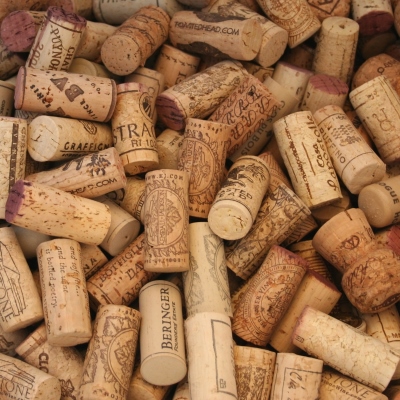CHICAGO WINE JOURNAL: If it smells like a wet pooch, dump that puppy
By Lawrence B. Johnson
 When you put your nose into a glass of wine and get an “off” smell, something more suggestive of a wet dog than fruit, chances are you’re holding a corked wine. If you think that first whiff is bad, just wait 20 minutes. It only gets worse.
When you put your nose into a glass of wine and get an “off” smell, something more suggestive of a wet dog than fruit, chances are you’re holding a corked wine. If you think that first whiff is bad, just wait 20 minutes. It only gets worse.
Before elaborating on what “corked” is, let’s get straight what it is not. It is not bits of cork floating around in your glass. Wine is in contact with the cork stopper from the moment it’s bottled. That’s no problem. Nor are those annoying fragments that sometimes flow into the glass with the wine. Just fish them out with the tip of a spoon. The wine’s fine.
What’s not OK is any wine that smells of mold, damp cardboard, damp pooch. That’s typically a sign of corked wine.
The term reflects the cause of the foul smell: a cork that has been corrupted by molds that produce the chemical compound trichloroanisole, or TCA. Generally speaking, TCA is not the result of less than ideal storage of wine bottles. The sources are manifold, starting with the way corks are washed and extending to molds that may occur and infect a cork all along the line of wine production.
Nor is TCA contamination selective. It is indifferent to the value of your prized wine. With friends, I once opened a $450 bottle (not mine!) of Le Montrachet, the incompaarable white Burgundy, only to find it corked. But I’ve also had my personal share of unhappy encounters with corked wine.
Over the years, I’ve poured hundreds of dollars’ worth of fouled wine down the drain. There’s really nothing else to do. An overly oxidized wine can at least be repurposed for cooking. But not a corked wine; the nasty flavor would only infect the food.
Ah, yes, flavor. Corkiness isn’t limited to smell. It kills a wine’s flavor, as well. And it builds on your palate. Persist in drinking a wine that you suspect is corked, and in short time the inside of your mouth will be painted with that unpleasant taste. Your glass also will be tainted. So when you start over with a new bottle, switch to a fresh glass.
 You never know which bottle, new or long-held treasure, will be corked. The industry-wide incidence is a hotly debated subject, but it appears to be somewhere in the broad range of 1 to 3 percent. I’ve had enough ugly experiences to know it’s a meaningful number. No wonder some producers have turned to the less-than-ideal option of artificial corks (which don’t breathe), and many others have turned to screw caps.
You never know which bottle, new or long-held treasure, will be corked. The industry-wide incidence is a hotly debated subject, but it appears to be somewhere in the broad range of 1 to 3 percent. I’ve had enough ugly experiences to know it’s a meaningful number. No wonder some producers have turned to the less-than-ideal option of artificial corks (which don’t breathe), and many others have turned to screw caps.
I admit to being a traditionalist; I like to pull corks. And it’s always dismaying to take that first whiff of something you’ve kept for years only to discover that it has been ruined, and probably by a corrupted cork. But you can’t know until you get to the wine itself: I’ve seen corks in old bottles simply disintegrate on pulling — and found the wine within to be fabulous. And I’ve had good, firm corks in bottles that were good for nothing but dumping.
It’s one thing when a beautiful old bottle from my cellar proves to be corked: I cry a little, then open something else. But a corked bottle served at a restaurant can create a truly awkward situation. A competent sommelier will acknowledge that the wine is bad. Someone less expert may tell you to give it a few minutes to “breathe.” All you’ll get from that is a wine with really bad breath.
I’ve left a trail of corked wines in restaurants from San Francisco to London to Dijon. At a charming mom and pop eatery in Santenay, Burgundy, I was served consecutive bottles of corked wine. When I rejected the second one, the owner (my waitress) blew up, but not at me. She was ready to strangle the local producer who had sold her the bottles, and whom she’d probably known since first grade. Don’t know how that worked out, but the third bottle she poured for me was delicious.
Tags: corked wine, wine trichloroanisole

